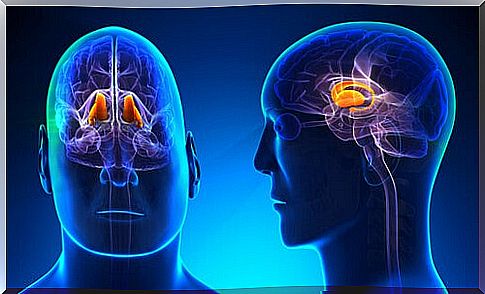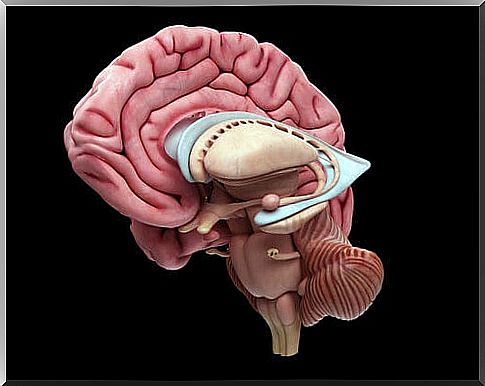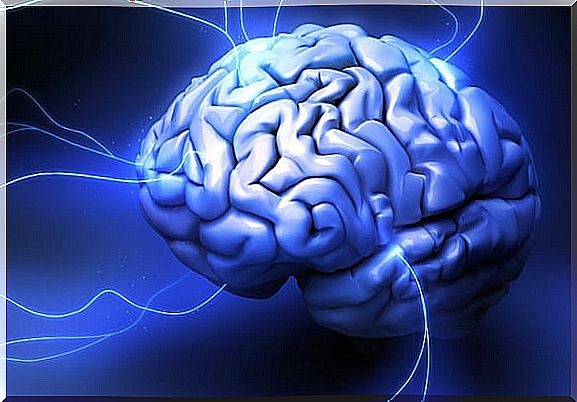The Thalamus: Its Characteristics And Functions

The thalamus is an oval-shaped structure that constitutes the dorsal portion of the diencephalon. It transmits sensory input to the primary sensory zones of the cortex, but it is more than just a repeater station.
The main function of the thalamus is the integration of sensory information directed to the cortex. It transmits most of the information that reaches the cerebral cortex and, in addition, integrates various sensory modalities and facilitates or inhibits projections towards some lobes or others.
It is essential for the maintenance of cortical activity. It is also responsible for transmitting information from the cerebellum and the striatum to the cerebral cortex. The cerebellum and striatum are centers that modulate the descending motor pathways of the cerebral cortex. Almost all sensorimotor information passes through the thalamus before reaching its destination (cortex).
The thalamus is organized into different nuclei with different functions. The only sensory information that does not take over from the thalamus is olfactory information, which passes directly from the olfactory bulb to the cerebral cortex. The rest of the senses: taste, vision, touch and hearing are released in the nuclei of the thalamus and then project it to its corresponding area in the cortex.
But in addition to the ascending information, it also deals with the descending information, the information that the crust sends to other areas. Although its main function is to regulate sensorimotor projections, it is also involved in the functioning of some higher functions, such as memory or language.
Thalamus organization

The thalamus is part of the diencephalon located at the base of the brain, between the telencephalon and the brain stem. In addition to the thalamus, three other subdivisions are part of the diencephalon: the hypothalamus, the subthalamus, and the epithalamus. It is the largest of the four subdivisions and consists of groups of neurons that project to all areas of the cerebral cortex.
Let’s say it is in a strategic place that allows it to be ” the functional gate of the cerebral cortex. ” Virtually all information arriving or descending from the cortex first passes through the thalamus. The nuclei of the thalamus are organized around the medullary lamina, which is shaped like a “Y”, dividing the thalamus into three parts: anterior, medial and lateral.
Regarding the function of each of the nuclei, we can classify them into relay thalamic nuclei and diffuse projection nuclei. The relay stations are intermediate processing stations in the sensory transit to the cerebral cortex, sending their projections to specific areas of the cortex. Those with diffuse projection are nonspecific: they do not send projections to specific areas.
Groups of relay and diffuse projection nuclei
Up to 50 nuclei have been identified. Thalamic relay nuclei are usually classified into four groups with respect to the internal medullary lamina (fiber bundle):
- Anterior : participates in memory and emotions connected with regions of the cingulate and frontal cortex.
- Medial : consists of three subdivisions, each connected to a specific region of the frontal cortex. It receives input from the basal ganglia, the tonsillar nucleus, and the midbrain. You have been involved with memory.
- Ventral : important for motor control, transmitting information from the cerebellum and basal ganglia to the motor cortex.
- Posterior : consists of the medial geniculate, lateral geniculate and pulvinar. The medial geniculate is a component of the auditory system, it transmits tonotopically organized auditory information to the temporal lobe. The lateral geniculate receives information from the retina and sends the visual information to the primary visual cortex of the occipital lobe. And the pulvinar projects to areas of parieto-occipital-temporal association, more developed in humans.
As for diffuse projection nuclei, they are located in the midline of the thalamus or in the medullary lamina. The intralaminar nuclei project to limbic structures, which govern the activation of the cortex, and perhaps participate in the integration of sensory submodalities. The reticular nucleus regulates the activity of other thalamic nuclei based on its control.
It is not only a relay station for simple transfer to the neocortex. It could be said that it is a complex brain region where a substantial degree of information processing is possible. It acts as a guardian of information to the cerebral cortex, preventing or facilitating the passage of specific information depending on the person’s state of consciousness.
The many functions of the thalamus
It is a complex structure that has implications for various functions of the central nervous system, these are some of them:
- Sensitive motor : it is responsible for the analysis and integration of sensitive functions. These can be mechanical, thermal and painful stimuli and collaborates in their perception. Its injury can cause sensory loss contralateral to the injury, paresthesia, or thalamic pain. At the motor level, it is involved in voluntary and involuntary movements and gait.
- Attention : evidence has been found on its involvement in the sleep-wake cycle and in the degree of consciousness.
- Emotions : it is responsible for the integration of visceral information with affection, emotions and thought.
- Language : mainly, it influences the motor aspects of language, although damage to the thalamus can also cause naming or syntactic problems.
- Memory: there is a clear implication of the thalamus in anterograde memory, that is, the formation of new memories. In addition, it collaborates in the temporary organization of recent and ancient memories. His injury is also related to diseases characterized by amnesia such as Korsakoff’s syndrome.
- Executive function : in its projections to the prefrontal cortex, it also modulates executive functions, attention, initiative, inhibition and the temporal organization of behavior.
As can be seen, its role cannot be limited to a single function : it modulates multiple sensory and motor modalities and even higher functions.
It can be affirmed, therefore, that the thalamus plays an important role in different brain functions including memory, emotions, sleep-wake cycle, executive functions. Average in general cortical responses of alertness, sensorimotor control and processing of sensory information.
Thalamus injury

The thalamus is a gray nucleus located at the base of our brain that serves as the intersection point of multiple neural pathways. The clinical manifestations produced by thalamic lesions are very diverse, poorly systematized and relatively little known.
In turn, these lesions respond to multiple causes, among which the vascular one predominates, although those of metabolic, neoplastic, inflammatory and infectious origin also stand out.
It integrates somatic, visceral and visual information related to emotional sensations and subjective states, influences the activity of the motor cortex and serves as a relay towards consciousness. So the levels of consciousness and alertness, emotional tone or recent memory can be altered, in addition to problems in sensitivity and movements.
We can speak of specific pathologies directly related to the thalamus injury. Two of these injuries would be Korsakoff syndrome or Dejerine and Roussy syndrome. The first characterized by problems in anterograde memory, fabrications and hallucinations. The second was due to intense pain, transient hemiparesis and hemiataxia.
As we can see, thalamic lesions continue to be a challenge for clinicians. The main reason is that this small gray nucleus is a connection point between different neural pathways : afferent connections that converge in it and efferent pathways that carry nerve impulses from the thalamus to other structures of the central nervous system.
Therefore, a lesion in the thalamus, depending on the affected area, as well as the etiology (infectious, vascular…); it can lead to a multiplicity of consequences. In fact, as recognized by professionals in the field, these injuries are “poorly systematized and relatively little known.” There is still much to investigate and learn about this key structure for proper brain function.









